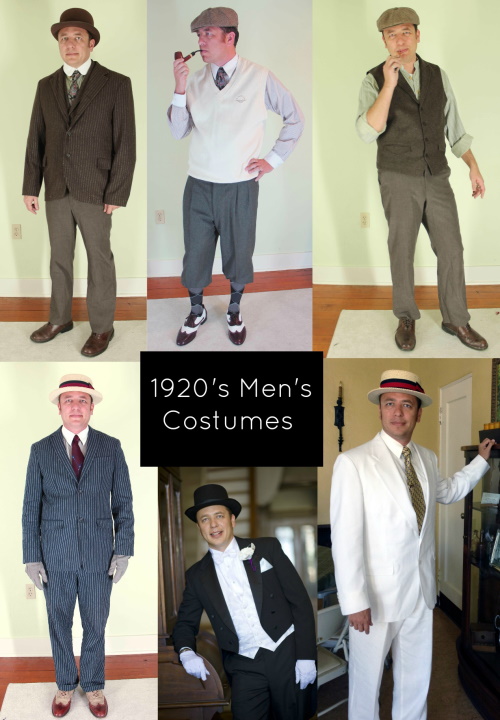A 1920s man dressed for his class or his job more than for an occasion, like women did. Upper-class gentlemen dressed in the finest suits, middle-class businessmen wore similar (but not as expensive) suits, and working-class men were in laborers’ clothes. Outside of work, men wore casual sporting clothes on the weekends.
This article will explore the many styles of men’s 1920s fashion with links to additional detailed articles on each clothing item.
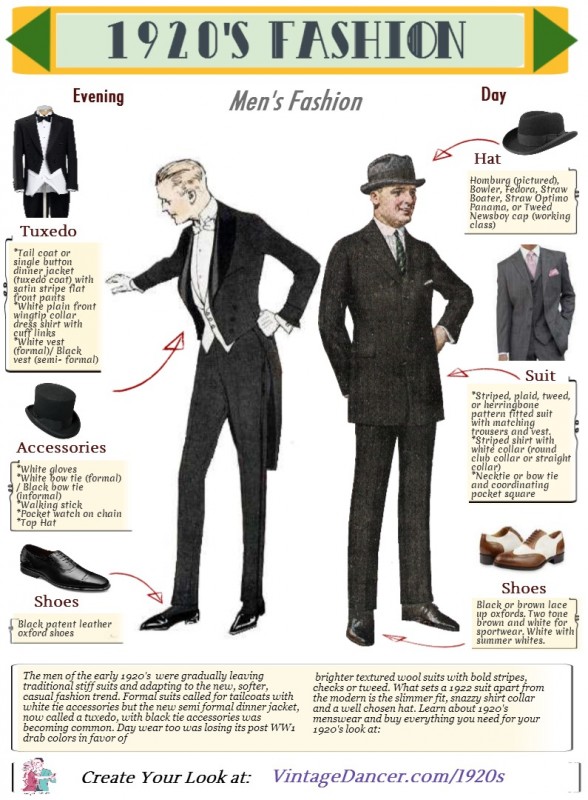
1920s Day and Evening Men’s Clothing Guide. Learn more.
Men’s 1920s Business Attire
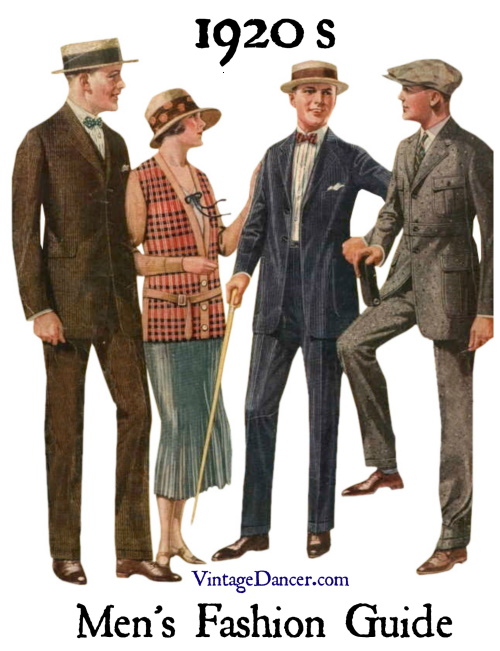
1920s men’s summer suits
A working family man would put his work clothes on almost immediately in the morning. He may have also put on his robe or smoking jacket while eating, reading the paper or fixing his hair.
A businessman wore an appropriate 3 piece suit to the office on business calls and often to dinners and parties, too. He was not subject to the multiple changes of clothing as women were. The type of suit changed with his seniority at work and the season. Some men in upper-level positions still wore men’s formal morning suits with cutaway coats, striped pants, cravats, and vests to work.
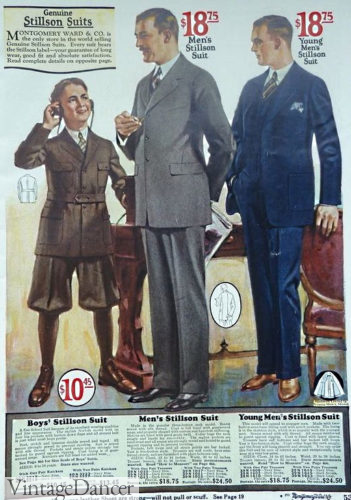
Mid 1920s conservative men and young men suits
Everyone else wore the quality of suit they could afford. Usually, a man had 3 or 4 suits he would wear during the week, changing shirts daily. Business suits were purchased with an extra set of pants since they wore out quicker than suit coats and vests. Dress shirts were striped with white round or pointed collars that were detachable up until the late 1920s. Cufflinks were also necessary. Learn more about men’s shirts here.
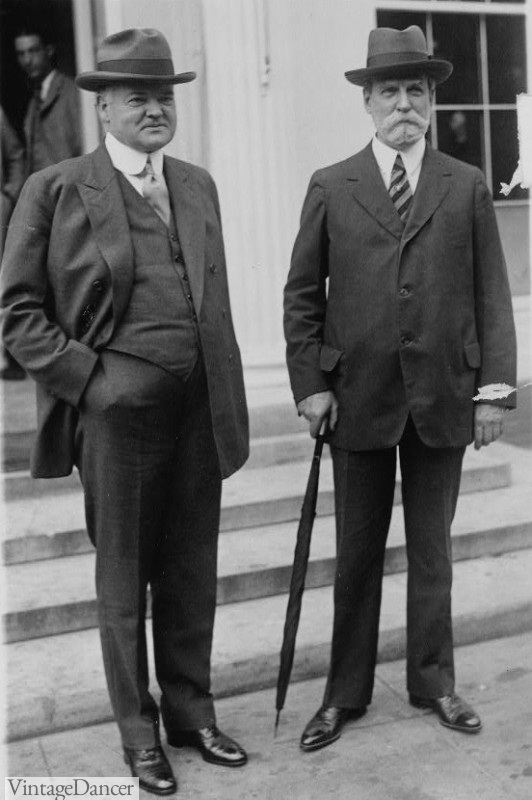
1925 Secretary of State Hughes wearing typical ’20s business suit
In the early years, suits were slim and plain colored. By the mid ’20s, the wide leg look with a loose suit coat made men much more comfortable. These also came in bolder wide stripes, big checks, windowpane, plaid, and tweed fabrics.
Gentlemen’s suits in the summer were nice white linen or seersucker suits. Suit jacks buttoned up with 3-4 buttons to mid-chest. The jacket hung down to the upper thigh and was worn over a matching lapel collar vest. Both coat and vest lapels were quite wide. The skinny “jazz suit” was a brief fad in the very late teens/the early ’20s only. Men wanted wide, loose clothing that felt as comfortable as their weekend attire starting around 1922.
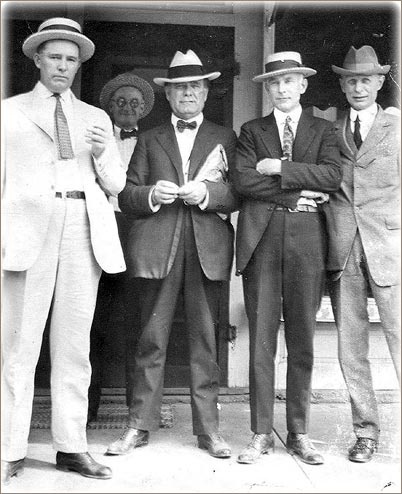
Men in summer suits and straw hats
Suit pants were wide, too, by the mid-20s. They fit very high on the waist and had to be held up with suspenders. They were usually flat front, creased down the center leg, and cuffed at the bottom. Men could wear a belt, too, but they were less common.
Suit accessories included a necktie or bow tie in patterns of wide stripes, small dots, and paisley. They were often coordinated with the pocket square folder in the chest pocket. Some well-dressed men wore a collar pin under the necktie to hold the collar in place. In cool weather, a wool topcoat kept a man warm.
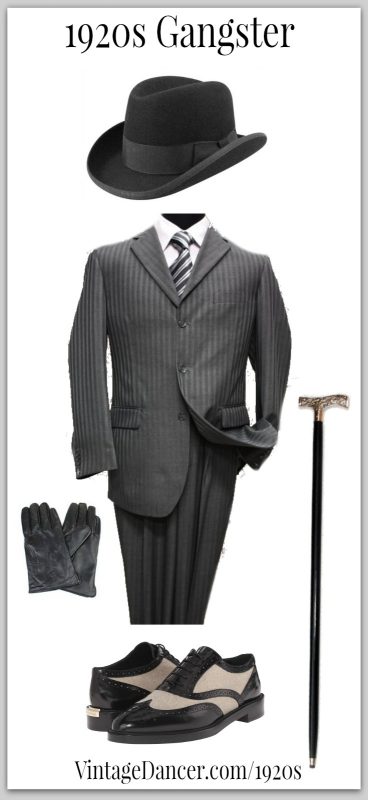
1920s Gangster look – Black Homburg hat, dark grey striped suit, two-tone shoes, leather gloves and a walking cane (or is it a weapon?)
Notorious gangsters and bootleggers of the 1920s wore 3 piece suits, too. What they wore was determined by their wealth, not their uh… occupation. Some well-to-do gangsters were known for wearing white spats over their boots, just like men did in the early 1900s. A walking cane or rolled umbrella was another accessory that said “old money.” Younger gangsters (the muscle and weapon men) wore whatever suits they could afford. They often did not have matching vests, and they fit poorly since they were purchased second hand. Learn how to dress like a 1920s gangster here.
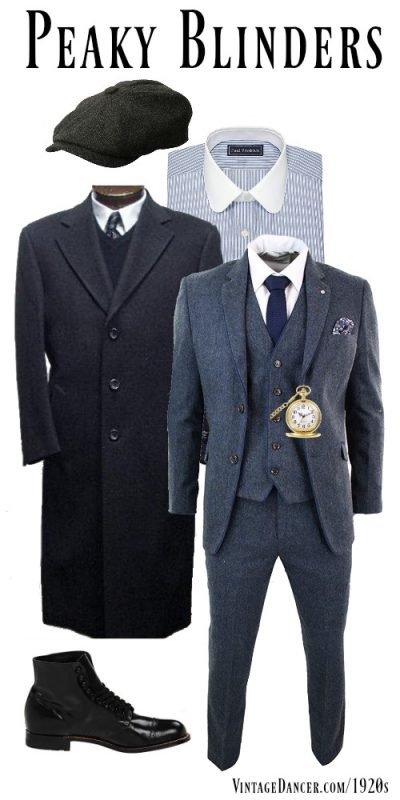
Peaky Blinders outfit guide. Click here.
Men’s Summer Suits
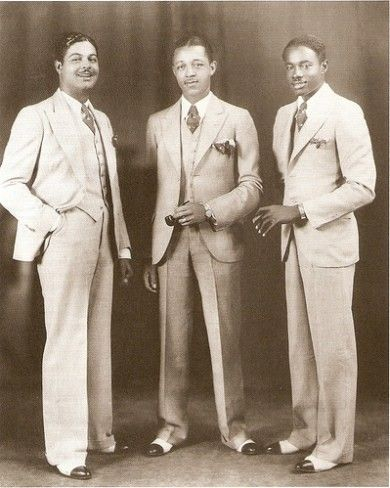
Dapper men in light cream/tan wool summer suits, two tone shoes
In summer, an all wool suit was too hot. Instead, men turned to light flannel, striped seersucker, or linen suits. There were a few years where pastel colors were popular such as the pink suit Gatsby wore, otherwise white, ivory, or beige were the best colors. Some men paired white pants with a double-breasted blue blazer for a yachting or nautical look.
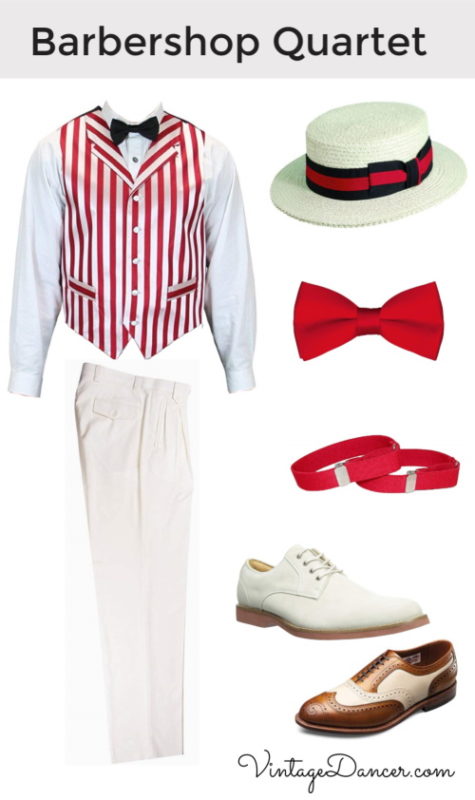
1920s barbershop quartet/musician costume
Musicians and college kids often wore wide striped blazers over white pants as a summer outfit. This look was popularized by Barber Shop quartet singers, ragtime pianists, and traveling salesmen (AKA The Music Man). Some modern costumes skip the blazer and wear a striped vest, bow tie, and armbands/sleeve garters instead. A straw boater hat completes the festive summer outfit.
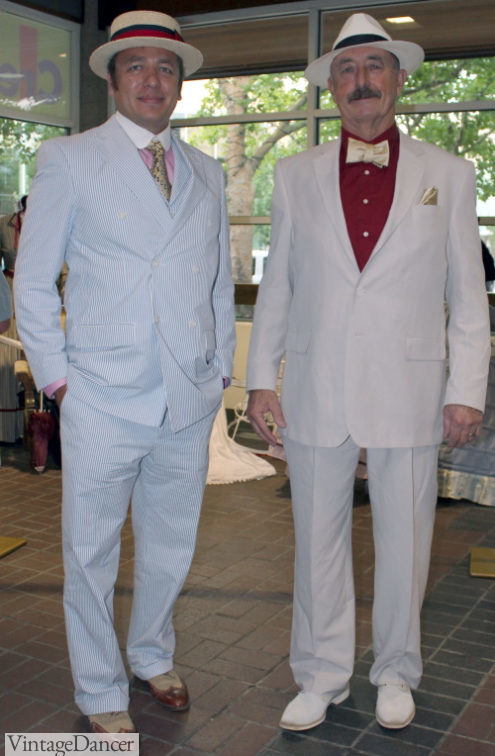
Seersucker suit on the left, ivory linen suit on the right. Both are perfect for hot summer events.
1920s Men’s Hats
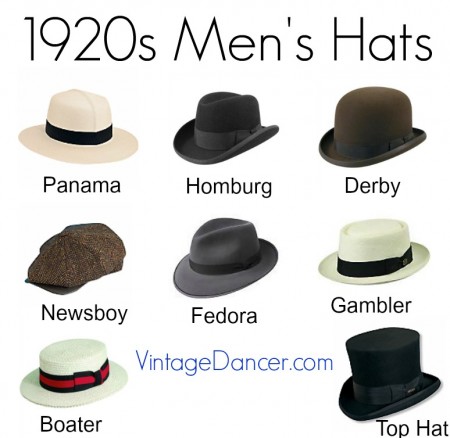
1920s Men’s Hat Styles- shop hats
Men wore hats out of the house just as the ladies did, although they were always taken off inside, which led to many men losing hats when placed on a community hat stand. Popular felt hats were the round bowler or derby hat, followed by the Homburg with a center crease in the crown. The felt fedora hat was a newer trend with a more casual appearance for the middle classes. Various other hat styles were shaped from felt or straw with rolled brims or tall crowns. A hat did not need to match a man’s suit, but should not stand out either. Common colors were grey, black and brown wool felt.
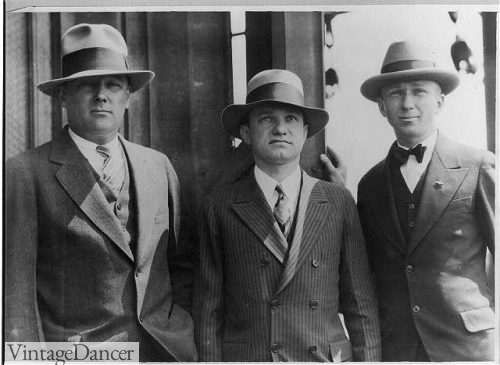
1927, men’s felt hats (L) Fedora, (M) round crown and (R) Homburg.
In the summer, men’s felt hats were tossed aside in favor of lighter straw hats. The straw boater and skimmer are what most of us think of as men’s ’20s hats. They had a round flat crown and striped ribbon that often represented a gentleman’s club or college colors. The lightweight straw Panama hat was expensive but much nicer than other thick straw boater hats. By the end of summer, straw hats were in shambles and thrown away. Learn more about men’s hat styles.
1920s Men’s Shoes
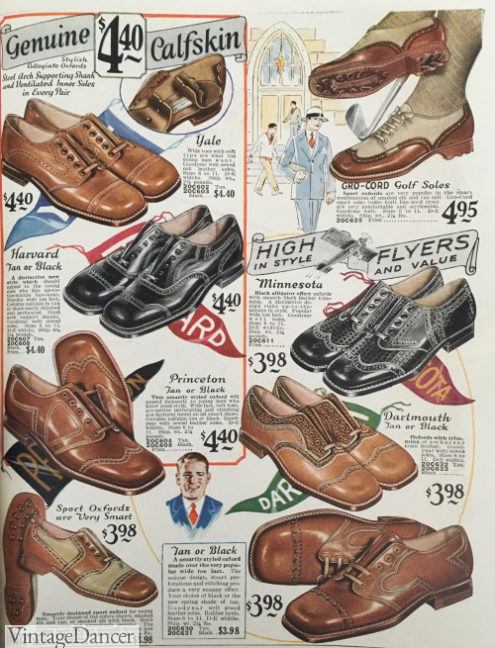
1928 men’s shoes
Men’s dress shoes consisted of lace-up cap toe, wingtip Oxford, or derby shoes. The most dressy Oxford was the wingtip with a distinct W design on the toe. Most middle-class businessmen opted for the simple cap toe Oxford in brown or black or white nubuck in summer. Some old men continued to wear lace-up dress boots.
With snazzy new suit colors came the trend of two-tone Oxfords. Usually brown and white, they looked very dapper. Saddle shoes in brown and white were another casual shoe, although a few came in black and white. Learn more about 1920s men’s shoe styles.
Men’s Working Class Clothing
Farmers, steel workers, miners, and railroad men all had a distinctive uniform or dress code. For a general manual labor position, sturdy denim, canvas overalls or coveralls, a plaid wool work shirt, and tough leather boots was the standard dress.
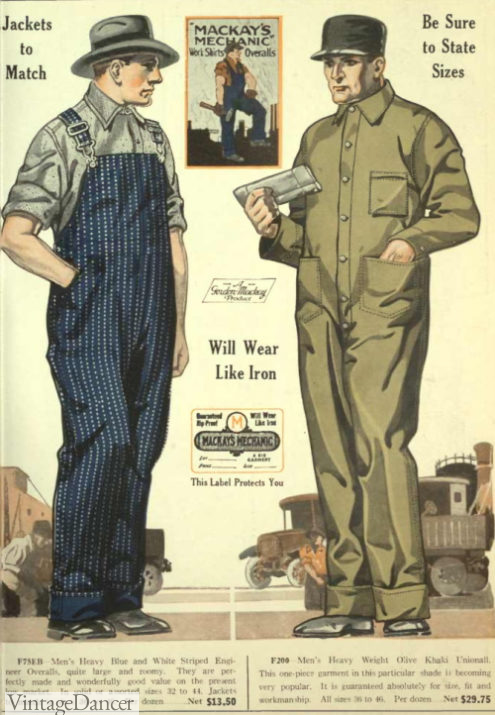
1921 overalls and coveralls
In cooler weather, a rain or oil slicker and fur-lined coat protected men from the elements. Manual labor was very hard. Progress was made for better labor conditions in the 1920s and more time off (yeah weekends!), but the work itself was extremely difficult and not very lucrative. Work clothing took quite a beating and needed to be mended and replaced frequently.
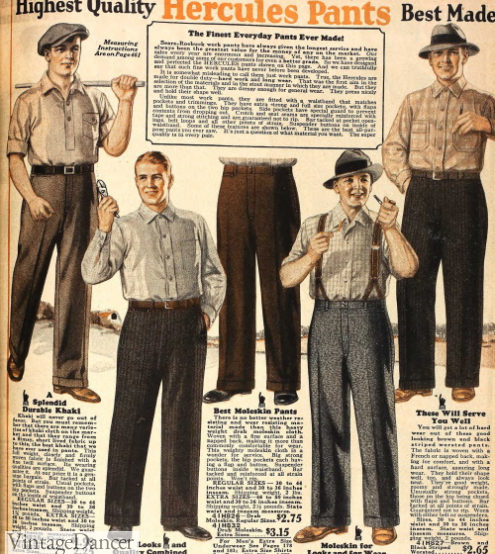
1927 men work shirts, pants, and caps
The hat for most working classes was the 8 panel cap, also called a newsboy cap. It was soft, wide, and puffy, made of wool or tweed. Railroad men sometimes wore striped train conductor style caps. Delivery drivers would wear a fisherman style cap. Other specific jobs require different types of uniform hats.
Learn more about men’s vintage workwear clothing.
Men’s Formalwear
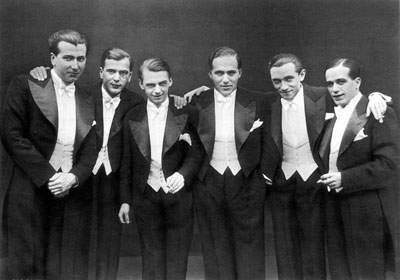
1920’s Mens White Tie Formal Wear
Men’s 1920s formalwear entailed a black tuxedo with tails or the new style of dinner jacket (now called a tuxedo coat). A white button-down dress shirt with wingtip collar and white or black bow tie was worn under a white or black U-shape vest. Wearing white was the most formal look, while black was for most semi-formal occasions. Black patent leather shoes and a top hat completed the formality.
Young men who did not have the means of purchasing a tuxedo were acceptable in their best suit. The old guard didn’t like this much, but establishments like the opera and theater had to lighten the rules, otherwise the young men could not afford it and the art form would die. The white dinner jacket over black pants wasn’t worn until the 1930s.
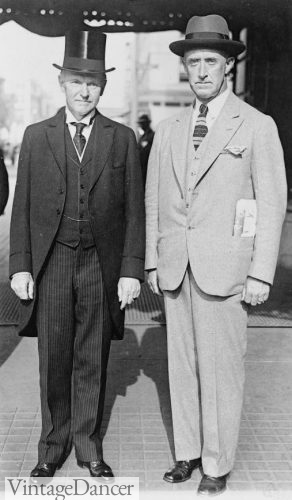
1929 Calvin Coolidge wearing a morning suit.
Certain occupations required men to wear formal clothing. Waiters, bartenders, butlers, hotel managers, and other service-oriented careers required men to dress in their finest formal attire. A lower class establishment, such as a neighborhood bar, would see staff dressed in a button-down shirt with sleeves rolled up to the elbow or help down with sleeve garters. Bankers often wore sleeve garters, too.
Another formal suit worn by business executives, politicians, and grooms was the morning suit. It consisted of grey and black striped pants, grey vest, black morning coat, wingtip shirt, tie, and top hat. It was a style that was fading quickly, except on special occasions and with the upper classes. It has come back around again today in wedding attire for grooms.
Men’s Casual Clothes
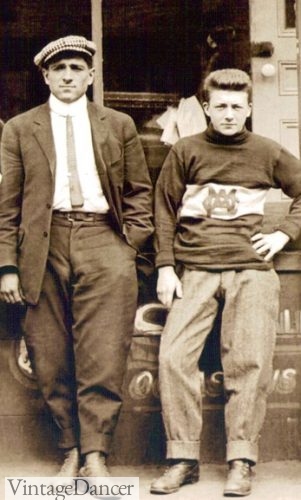
Casual men’s clothing (college age)
Sports clothes for men included a pair of pants or knickers called plus fours. These knee-length pants were paired with a patterned sweater or pullover vest and a long sleeve button down shirt with the sleeves rolled up. Argyle was a common sweater or vest print as well as a print for tall socks. Clashing colors were in style! An 8 panel cap (newsboy cap) was also worn, and a pair of two-tone Oxfords or saddle shoes were snazzy.
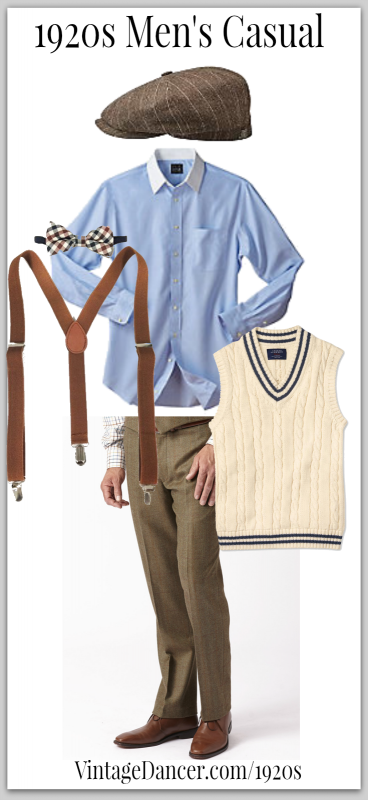
Casual 1920s look can be worn with or without a pullover vest.
Any time a jacket was not worn, a vest was exposed. The current trend for dapper men wearing pants, a vest, shirt, and bow tie (no jacket) reflects this twenties fashion.
For a casual summer outfit, white pants were worn with a casual button-down shirt and white pullover vest or sweater for a look inspired by tennis players.
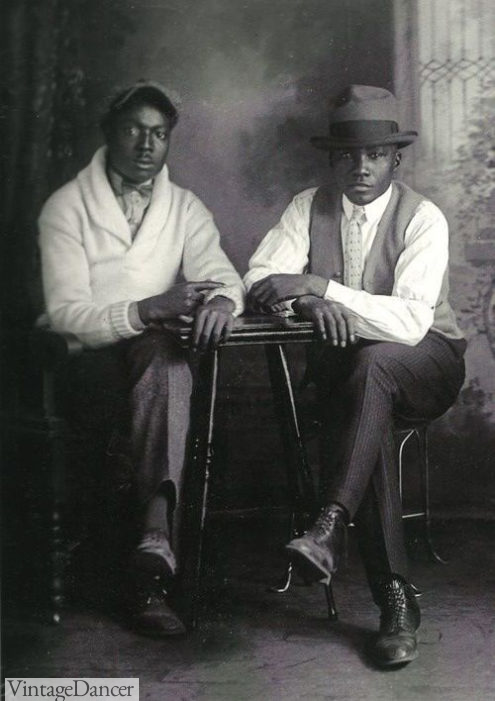
Semi-casual – Sweaters, vests, trousers and hats
College men wore looser suits, often without jackets – just a pair of pants, shirt, tie, belt and maybe a vest. Hats were optional as well. Raccoon coats were not. Whatever the trendy fashion of the year was, college kids had to wear it. They also had to wear college colors in a scarf, a pocket square, bag, hat band, pin, or ring. School spirit was vital to the dress code.
More Men’s Outfit Ideas
Easy 1920s men’s costume ideas – See how I created 10 men’s looks, from casual to formal.
1920s Men’s Outfit Inspiration & 20s Costume Ideas
Accurate 1920s Classic Car Show Costumes
1920s Men’s Vintage Casual Outfit Ideas
Mens Vintage Boating Outfits, Sailing Clothes
Summer Clothing and Gatsby’s white suits recreated.
Debbie Sessions has been teaching fashion history and helping people dress for vintage themed events since 2009. She has turned a hobby into VintageDancer.com with hundreds of well researched articles and hand picked links to vintage inspired clothing online. She aims to make dressing accurately (or not) an affordable option for all. Oh, and she dances too.
